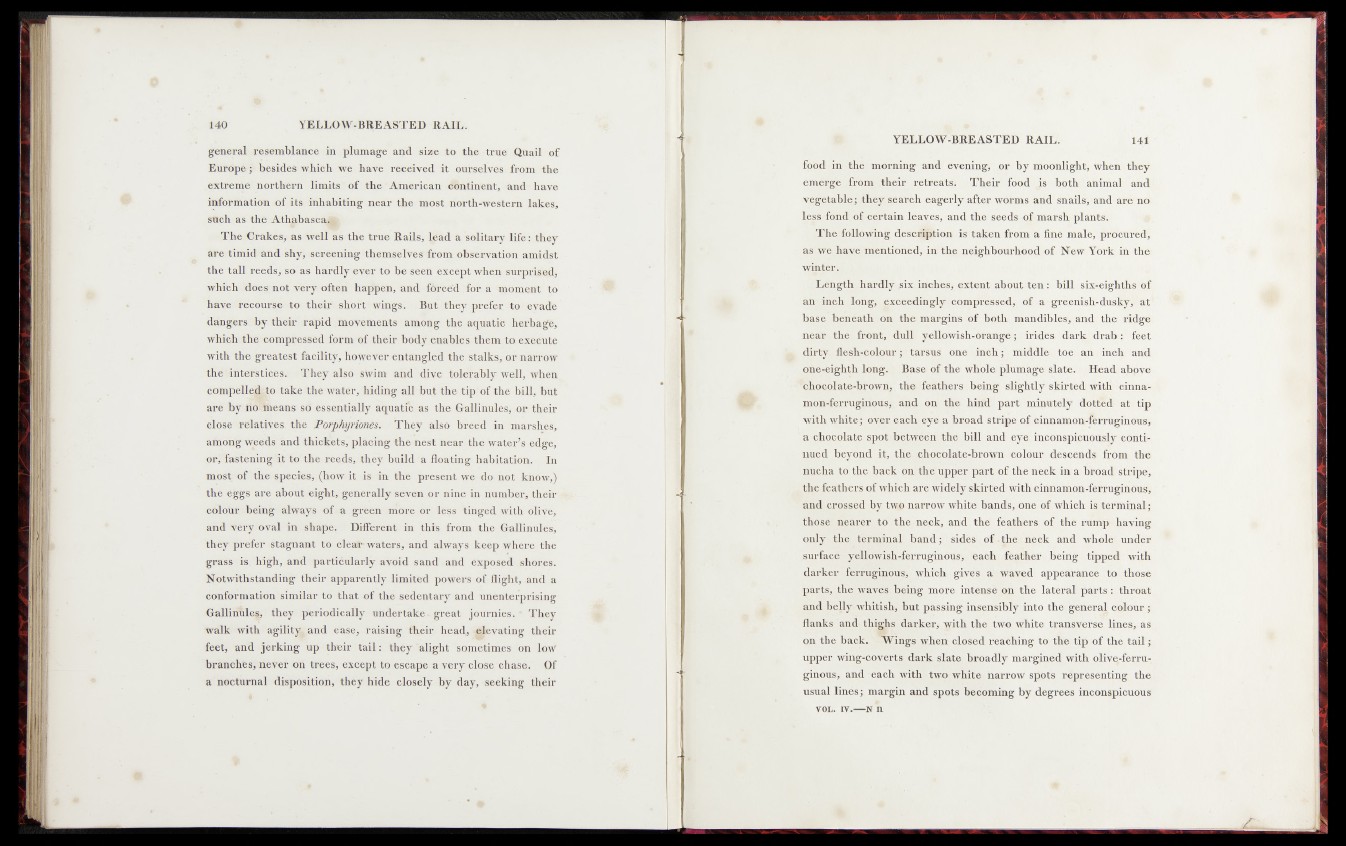
general resemblance in plumage and siae .to the true Quail of
Europe / besides which we have received it ourselves from the
extreme northern limits’ of the American «IRntin'eùt, and have
information of its inhabiting near the most north-western lakes,
such as the Athabasca^fc
The Crakes, as Well as the true Rails, Jpad a solitary life : they
are timid and shyj .'screeningthemselves from observation amidst
the tall reeds, so as hardly ever to be seen except when surprised,
which doefjnot Yery often hajjpen, and fèreed for a moment tp
have recourse to their" short wings. But they prefer ^ « y n é lé ’
dangers : by their rapid movements among the aquatib herbage,
which the compressed form of their body enables them to execute
with the greatest facility, however-entangled the stalks, or-nâr-row
thd ‘Mtefstices. They also swim and dive, .tolerably well, when^
cojnpelledjjto take<Wie water, hiding all but the tip*"of the' bill, bite
are by n^feeans'sâfèSàeatially aquatie^Us the Gallimteésispr their
close relatives, the JPorphyriones. They also breed iri^ÿnarshés,
among weeds and thickets, placing the nest near the water’s edge,
or; fastening it to the reeds, they build a floating habitation, ^ n
most of the species, (how it -is in the present we do not know®
the eggs are about eight, generally seven or nine in number., their-
colour being always of a green .more or lèss tinged with olive;
and Ye-ry oval in shape. Different in this from the Gallinules,
they prefer stagnant t® cleat“ waters, and always- keep; where th#
grass is. high, and particularly avoid sand and exposed shores.
Notwifhstanding their apparently limited powers of flight, and a
conformation similar to that of the sedentary and unenterprising
G&Iliirale|? they periodically, undertake-great journies. * 'They
Walk with ag ilit^ an d ease, falsing their, head, -ftkevating their
feet, and jerking up their tail : they' “alight sometimes on IcnY
branchfespriever on trees, except to escape a very close chase. Of
a nocturnal disposition, they hide closely hy day, seeking their
YELLOW-BREASTED RAIL. 141
feodliin* bhej^prhjiftg and evening, ór^by mqdülight, when they
emerge from their’ retreats: Their foOdj^s^ both animal and
vegetable; they search eagerly afti^wohms; find snails, and are no
less fond;o§eertaim*;l|aves, and’ ,t$Le'*sèeds df marsh plants.-
The following d e s e rtio n is taken from ^^lëiihalej'proïctLfed^
as|we have mentioned, iraiftbe neighbourhood York in the
winter..
Length hardly /ix inches, extent affeut ten : bill six-'eighths of
am inch long, exceedingly ^©ftqJressqd;;- of -a" gfe^®lsh-düsky,^at
base benéath on the margins of both mandibles«/ and*, the ridge
near the, front, dull; yellowish-orange ; ^ irides dark drab, y feet
dirty«.*fl^sh-colour p‘tarsu,s on'd^liheh; middle, t o e ^ a t t ‘and-
e^ëifeighth long. Base of the whole. plulAag’etslate. * Head a h ^ tt
xepcplate-brown, th0 fehthers being slighdy’ató^éd''with '©inn®^,
mon-ferruginous, and on the hiifd part minutely doited- at tip
with white; over each eye a broad stripe of einn-afoion-frrnigiinkf“-ré,
a 0h,obolate gpbt- betwéen the.bill and inconspieU^sfy xöhtiïmpd
beyond it, the .^fepepfate-brown colour deséqttdsfe from thé*
nucha^to.the back pn theiupper part of thé nfeefe a-jfedtil stripe,
the feathers of which are'widely skirted with cinnamon-ferruginous;*
and crossed by twf> narrow white bands, one of which.i^terminal;
those nearer to.the ngpk, and the feathers of the rump^having
only, the terminal band; sides, of .the neck and whpfe under
.surface yellowish-ferruginous, each feather being tipped with
darker ferruginous, which gives a wahjp*d‘ appearance to- th'OSf»
parts, the waves being more iritènsé on the late^a%parts: throat
and belly whitish, but passing-insensibly into tm tshneral colour -T
flanks and thighs darker, ^ ith the* two white transverse lines, a$,
Oft the back. -Wings wben,^<^%èd:-reaföhing to tn’e tip of the tail;;
upper wing-coverts dark slate, broadly marg$ft$<É|with olive-ferru-
ginoiis* and each m ffe tw hwhite- narrow spots f *tertesepting thej
usual lines; margin and spots becoming by degrees inconspicuous
VOL. iv.-—n n